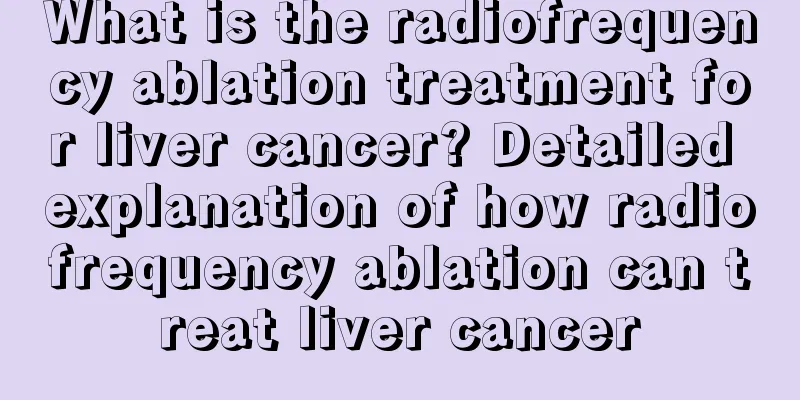What is the radiofrequency ablation treatment for liver cancer? Detailed explanation of how radiofrequency ablation can treat liver cancer

|
Primary and metastatic liver cancer is a common malignant tumor of the liver in my country. Due to its high malignancy, the prognosis is poor. Surgery and catheter interventional therapy have been widely used as effective treatment methods in clinical practice and have been accepted by physicians and patients. In recent years, percutaneous radiofrequency ablation therapy, as an emerging new treatment technology, has been gradually applied in clinical practice and has been popularized. principle: The main principle of radiofrequency ablation is that the radiofrequency electrode head emits medium- and high-frequency radiofrequency waves, which can stimulate tissue cells to produce plasma oscillations. The ions collide with each other to generate heat, reaching 80~100℃, which can effectively and quickly kill local tumor cells. At the same time, the high heat can coagulate the vascular tissue around the tumor to form a reaction zone, which prevents it from supplying blood to the tumor and helps prevent tumor metastasis. Treatment: Puncture and insert the needle under the guidance of imaging equipment such as CT, B-ultrasound, and C-arm. After the puncture is accurately positioned, radiofrequency ablation treatment is performed. The power of radiofrequency ablation is selected, generally starting from a low power of 20W, and gradually increasing the power by 10 to 20W every 1 to 2 minutes. When the tissue solidification impedance increases and the energy decreases, radiofrequency ablation will automatically stop, and a treatment can be completed. Advantages of radiofrequency ablation: ①Minimally invasive, no surgery required. ② Rapid effect and short treatment time. For diseases with a diameter of less than 5 cm, only 10 to 15 minutes of radio frequency is needed to achieve inactivation. ③ Safe and reliable. It can kill tumor tissue reliably and cause little damage to surrounding normal tissues. Intraoperative reactions and postoperative complications: During the intraoperative treatment, patients will experience varying degrees of distension, pain, and heat. Some patients may experience a decrease in heart rate, which can be treated with intramuscular injection of atropine. Occasionally, breathing difficulties may occur, which can be relieved by oxygen mask administration. Postoperative complications include: ① Pain in the liver area. When the tumor is located at the edge of the liver, the pain is particularly obvious. When the tumor is located in deep tissue, pain generally does not occur. ② Fever: The patient starts to have fever on the second day after surgery, with body temperature fluctuating around 38°C and reaching a maximum of over 39°C. The body temperature usually returns to normal within a week after the application of hormones and antibiotics after surgery. The cause is absorption heat caused by tumor necrosis absorption. ③ Jaundice and ascites: Radiofrequency causes necrosis of normal liver cells around the tumor, and the impact on liver function is the main cause of jaundice and ascites. ④ Pneumothorax: Correctly selecting the needle insertion point and avoiding the costophrenic angle can prevent pneumothorax. ⑤ Gastrointestinal perforation: Patients whose tumors are close to the gastrointestinal tract or whose tumors and gastrointestinal tracts are adhered may suffer from heat damage to the intestines during treatment, or the electrode may pass through the gastrointestinal tract when the needle is opened, which may cause gastrointestinal perforation and require surgical treatment. ⑥ Bleeding: The incidence rate is 0.46%~1.6%, mostly due to coagulation dysfunction in cirrhosis Radiofrequency therapy is a safe and effective treatment for liver space-occupying lesions, and has been recognized by many doctors and patients in clinical practice at home and abroad. At the same time, combined with transcatheter embolization (TACE) therapy, it can achieve a synergistic effect. The promotion and use of this method will provide a new treatment method for liver tumor patients, especially those with hypovascular tumors, greatly improve the quality of life of liver cancer patients, prolong survival, and provide conditions for radical cure of tumors. |
Recommend
Be careful of hematuria and urinary tract irritation causing bladder cancer!
What are the symptoms of bladder cancer? Correctl...
How to tell the authenticity of Antelope Cold Capsules?
Antelope Cold Capsules are a very common Chinese ...
How many meridians are there on the legs
As people pay more attention to meridian care, fi...
Can I use water spray to treat red blood streaks on my face?
There are many reasons for red blood streaks on t...
Is it okay to have hair tattoo on a bald head? Let’s talk about the causes of baldness first
Many bald patients will choose to use hair tattoo...
How to clean juice dripping on clothes
Fruit juice is very difficult to clean if it drip...
Introduction to dietary therapy for gastric cancer
Gastric cancer, also known as "gastric adeno...
Low-glycemic banana
There are many people in China who suffer from hy...
What is the treatment for spinal artery embolism?
Spinal artery embolism is a disease with a relati...
How long can glioma patients live
How long can glioma patients live? This is the mo...
What should I do if my facial skin becomes dry, flaky and stinging?
Skin is the most direct display of a person's...
Does gastric bleeding require a gastroscopy?
We always hear people talking about gastric bleed...
Can rectal cancer undergo minimally invasive surgery?
Usually, laparoscopic surgery involves operating ...
Be careful of these symptoms if you don't have surgery for hemorrhoids
Many people have never had hemorrhoids. Apart fro...
Name of medicine for treating neuropathy
Everyone knows that if you suffer from a mental i...









